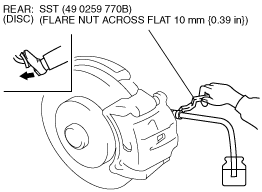 |
b3a0411w003
AIR BLEEDING
id041100800200
1. Remove the bleeder cap on the brake caliper, and attach a vinyl tube to the bleeder screw.
2. Place the other end of the vinyl tube in a clear container and fill the container with fluid during air bleeding.
3. Working with two people, one should pump the brake pedal several times and depress and hold the pedal down.
4. While the brake pedal is depressed, the other should loosen the bleeder screw, drain out any fluid containing air bubbles, and tighten the bleeder screw.
b3a0411w003
|
5. Repeat Steps 3 and 4 until no air bubbles are seen.
6. Perform air bleeding as described in the above procedures for all brake calipers.
7. After air bleeding, inspect the following: